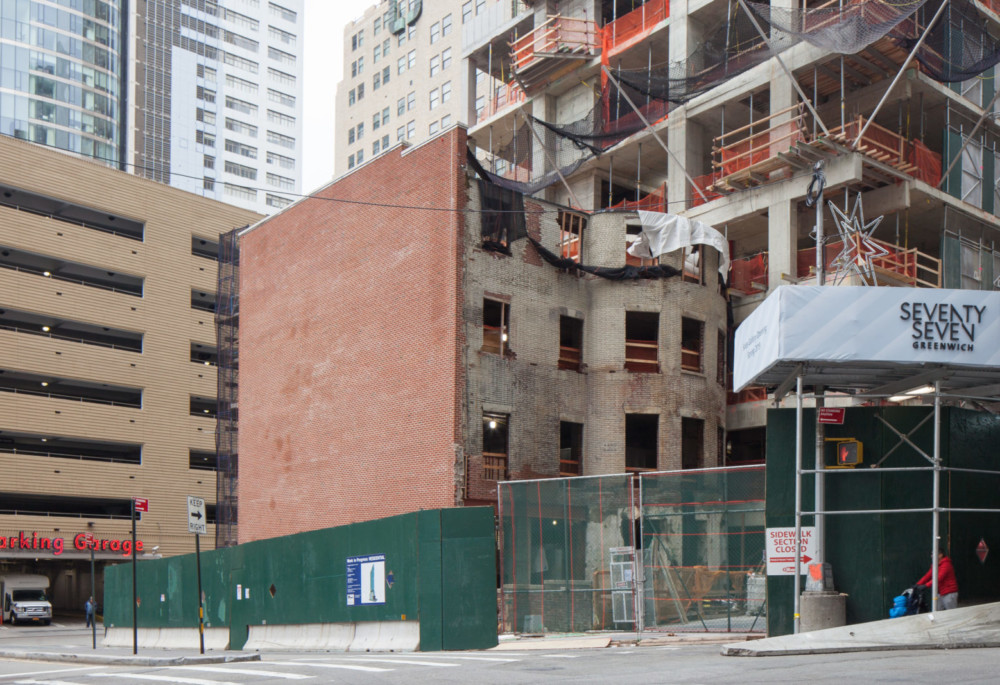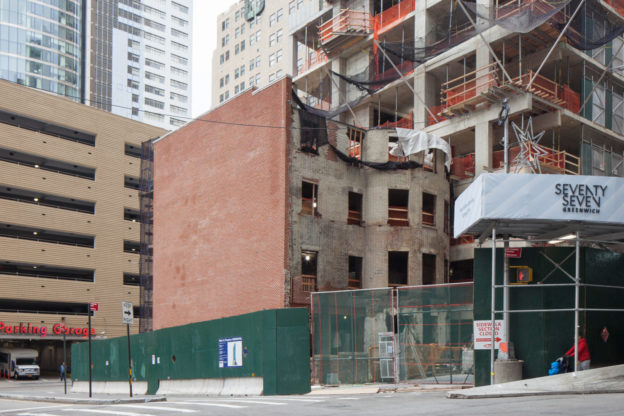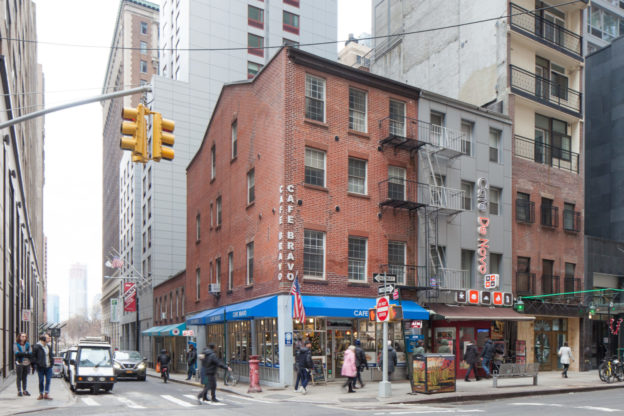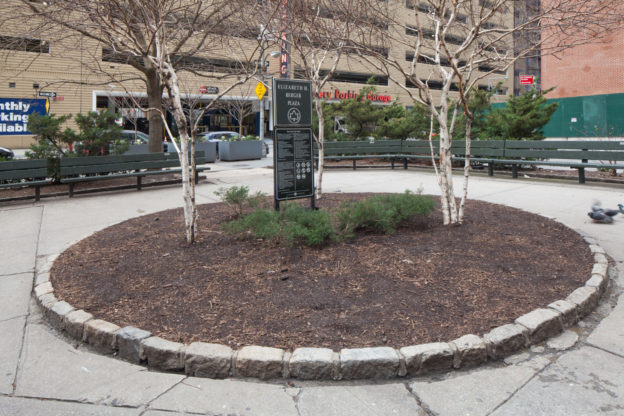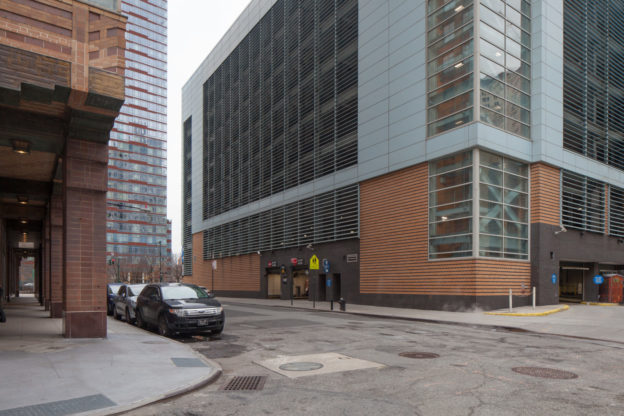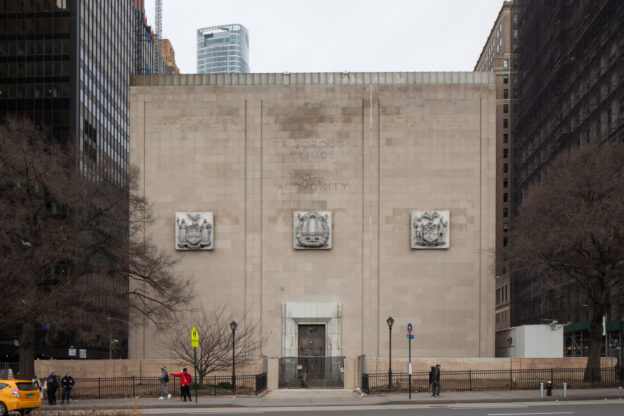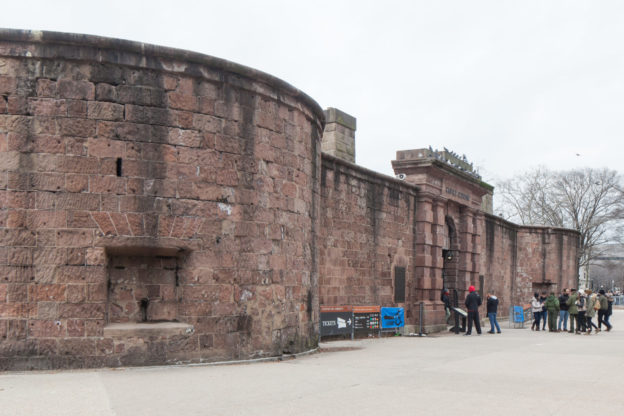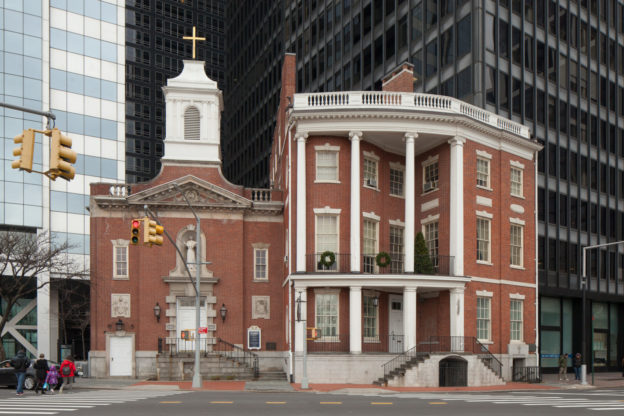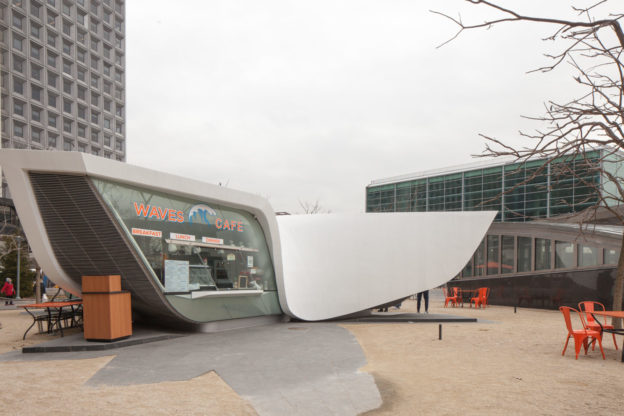67 Greenwich Street
1809-10
The Robert and Anne Dickey House was built in 1809-1810, making it one of only a handful of houses surviving from this period in Manhattan. The four-bay front facade features Flemish bond brickwork, flat and splayed keystone lintels, and a later door hood installed as part of an 1872 renovation by architect Detlef Lienau, when the building was in use as a tenement. The rear of the house retains the most striking feature of its Federal- period construction, which is the rounded bay facing Trinity Place. The Dickey House will serve as the entrance to the new school in the base of a tower rising directly next to and behind it. The Dickey Home is a NYC Individual Landmark.
Photo courtesy of The Library of Congress.
94 Greenwich Street
ca. 1799-1800
The three-and-a-half story brick house standing at the northwest corner of Rector and Greenwich Streets is among the remarkable group of Federal-era houses still surviving below Chambers Street, the oldest section of the city. 94 Greenwich Street still retains its Flemish-bond brickwork, splayed brick or marble lintels (on the Greenwich and Rector Street facades, respectively), and the top section of its original peaked roof, visible along Rector Street. Other survivors of this early period include the Watson House at 7 State Street and the Dickey House at 67 Greenwich Street. At
the southeast corner of the intersection is George’s restaurant, established in 1950 and apparently the last of the area’s Middle Eastern businesses. George’s suffered significant structural damage in the events of September 11, and owner George Koulmentas, with his son Billy, chose to rebuild in place as a low-scale restaurant. 94 Greenwich Street is a NYC Individual Landmark.
Photo by Christopher D. Brazee, NY Landmarks Preservation Commission.
Edgar Street, Greenwich Street, Trinity Place
2019
NYC Dept. of Parks and Recreation, Sara Ouhaddou, artist
For several years local advocates have been pushing the city to embrace their plan of combining the two small pocket parks located at the juncture of Greenwich Street, Edgar Street (reputedly the shortest street in Manhattan), Trinity Place and the Brooklyn- Battery Tunnel exit into one larger, continuous park. Their efforts are bearing fruit: the City is set to begin construction on what will be known as Elizabeth H. Berger Plaza, in honor of the late head of the Downtown Alliance. The plaza’s design will reroute the tunnel exit and merge the largely hardscaped parks into a unified landscape featuring more greenery with public art by Franco-Moroccan artist Sara Ouhaddou. Through the efforts of the Washington Street Historical Society, the plaza will also honor the local Syrian and Lebanese-American heritage by incorporating interpretive displays on Little Syria and its notable Arab-Americans residents, like writer and artist Kahlil Gibran.
Cunard Building
1917-21
Benjamin Wistar Morris with Carrere & Hastings
The intersection of Morris and Greenwich Streets perhaps best embodies the economic and technological forces that reshaped Little Syria, and Lower Manhattan in general, over the course of the 20th century. On the southeast corner stands the rear facade of the massive Cunard Building, one of the first major skyscrapers to be built under the 1916 zoning resolution, which established
certain limits on building bulk and massing in order to avoid the complete “canyonization” of Lower Manhattan. Across the street from the Cunard Building lies the giant trench that is the exit to the Brooklyn-Battery Tunnel, a monument to mid-century automobile-based urban planning. It is here that Greenwich Street forks off into Trinity Place, notable as the location where one of Manhattan’s earliest elevated rail lines split into two lines running northwards along Sixth and Ninth Avenues, respectively. A historic mast-arm lamppost remains at the north side of Morris Street, in the section of median that will shortly become the southern part of an expanded, redesigned Elizabeth Berger Plaza. Famed photographer Berenice Abbott photographed Morris Street at Greenwich Street in the 1930s, capturing the last remaining tenement building juxtaposed with the towering Cunard Building. The Cunard Building is a NYC Individual Landmark and listed on the State and National Register of Historic Places.
Photo courtesy of The New York Public Library.
Battery Place, Greenwich Street to Washington Street
1940-50
Ole Singstad, chief engineer through 1946; Ralph Smille, chief engineer after 1946; Erling Owre, architect
The Brooklyn-Battery Tunnel, which connects Lower Manhattan with Brooklyn, was constructed over a ten-year period from 1940 to 1950—including a three-year wartime hiatus—and is the longest tunnel of its type in North America. It replaced the low-rise buildings of the former Syrian Quarter. The severe-looking Moderne style ventilation building at Battery Place was designed by Parks Department architect Aymar Embury II and completed in 1950. The facade inscription facing Battery Park commemorates the 1946 consolidation of the city’s Tunnel Authority and Triborough Bridge Authority into the Triborough Bridge and Tunnel Authority. The other architecturally notable vent building is the white octagon located off the northern tip of Governors Island, designed by the successor firm to McKim, Mead, & White. The Tunnel was renamed in 2012 in honor of former New York State Governor Hugh L. Carey. Historic photo courtesy of The Library of Congress.
Castle Clinton: 1808-11, Lt. Col. Jonathan Williams and John McComb, Jr.
Originally sited on an island some 300 feet off the Battery, Castle Clinton was built for the War of 1812 as one of a pair of fortifications, the other being the still-surviving Castle Williams on the northern shore of Governors Island. The horseshoe-shaped brownstone monument has seen many and varied incarnations during its over 200-year history, including pleasure garden and concert hall, aquarium, ruin and finally National Monument. It also served as an immigration station, processing nearly eight million immigrants newly arrived in America — as compared to the roughly 12 million immigrants who passed through Ellis Island, its successor.
During the 1930s and 40s Castle Clinton was at the center of an epic preservation battle between legendary city Parks Commissioner Robert Moses and opponents of his plan to raze the structure for a parkway and bridge connecting Manhattan’s Battery with Brooklyn. A coalition of historic, art and landscape societies, led by the Regional Plan Association’s Robert McAneny, advocate Albert S. Bard, Manhattan Borough President Stanley Isaacs, and admiralty attorney C. C. Burlingham organized as the Central Committee of Organizations Opposing the Battery Bridge to fight Moses’ plan. Moses lost, Castle Clinton was declared a National Monument in 1946 and the Brooklyn-Battery Tunnel was built instead. Castle Clinton is a NYC Individual Landmark and listed on the State and National Register of Historic Places.
7 State Street
1793
attributed to John McComb, Jr.; extension 1806
Originally constructed in 1793 as the elegant private residence of James Watson, a merchant and the first Speaker of the New York State Assembly, the Federal style mansion at 7 State Street is a remarkable survivor from the early period when Lower Manhattan was home to the city’s wealthy and fashionable families. It is also notable for its long association with the history of Roman Catholicism in America.
Elizabeth Ann Bayley (1774-1821), a Staten Island native and religious pioneer who later became the sainted Mother Seton, briefly lived at 8 State Street before an 1803 trip to Italy that resulted in her conversion to Roman Catholicism (in an 1805 ceremony that took place nearby at St. Peter’s Roman Catholic Church on the corner of Church and Barclay streets). In 1884, 7 State Street became home to the Parish of Our Lady of the Rosary to better serve the Irish immigrants. In 1965, it was restored and protected with landmark status and, in the same year, the Classical-Revival style Our Lady of the Rosary church containing a shrine honoring Saint Elizabeth Ann Seton was constructed immediately to the left. The first American citizen to reach official sainthood, Mother Seton was canonized in 1974, on the 200th anniversary of her birth.
To the east of the building was the Leo House, a settlement house founded by the German Catholic Church in 1889 to serve German immigrants. The settlement house moved in 1926 to West 23rd Street in Chelsea. To the right of Mother Seton Shrine sits a skyscraper at 1 State Street Plaza, a building which began the wave of displacement faced by the immigrant community of the area by replacing the tenements and rowhouses that formerly occupied its space. Mother Seton Shrine is a NYC Individual Landmark and listed on the State and National Register of Historic Places.
2011
NYC DOT; AECOM, construction manager; Michael Victor Ruggiero, Landscape Architect; Ben van Berkel, UNStudio, Sculptor
Situated at the foot of Manhattan within view of New York Harbor, this plaza memorializes the early contact between the Native American inhabitants of Manhattan and its European explorers. Its centerpiece, the Plein and pin-wheel-shaped Pavillion, was donated by the Kingdom of the Netherlands to commemorate Henry Hudson’s arrival in 1609. The plaza’s namesake, Peter Minuit, was the third Director of the Dutch New Netherland colony, who in 1626 entered into an agreement with the indigenous Lenape. Though widely considered an outright purchase by subsequent colonists, this agreement was closer to a shared use contract allowing both parties equal access to live on and harvest the bounty of lower Manhattan. By the 1660s, the settlement of New Amsterdam was a thriving and diverse trading port with 18 languages spoken in the neighborhood. A bronze replica of the 1660 plan is on the north side of the plaza at State Street. Today, this plaza and transit facility is the city’s “busiest intermodal hub,” serving commuters by foot, bike, ferry, subway, and bus.
Photo by Wally Gobetz.
AFRICAN AMERICAN
144-146 West 131st Street, Manhattan
1883, William J. Merritt
170 West 130th Street, Manhattan
1884, William J. Merritt; 1928, altered by Vertner Woodson Tandy
Originally constructed for the Baptist Church of the Redeemer, this freestanding Romanesque Revival style building is of great cultural importance to the city for its ties to the Civil Rights Movement of the 1950’s-60’s. After changing hands several times, it was sold in 1936 to the Friendship Baptist Church, founded by the Rev. Dr. John Iverson Mumford. From the beginning, the church supported Civil Rights. Its second pastor, Dr. Thomas Kilgore Jr., was an associate of the Rev. Dr. Martin Luther King Jr., who delivered a sermon here in 1955. Among Rev. Kilgore’s other local and national Civil Rights efforts, he led the church to found the House of Friendship Community Center, which, in 1963, became the National Headquarters for the March on Washington for Jobs and Freedom, organized by Bayard Rustin. The congregation, still active today, was deeply involved in organizing the Harlem community’s participation in that historic March. In addition to its social and political significance, 170 West 130th Street’s façade is architecturally significant as the work of Vertner Woodson Tandy, the first African-American architect registered in New York State. The House of Friendship Community Center is located in the Central Harlem West — 130-132nd Street Historic District.
